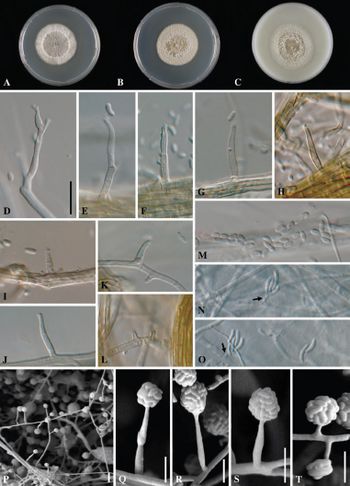Phaeoacremonium fraxinopennsylvanicum
From Pestinfo-Wiki
| Literature database |
|---|
| 18 articles sorted by: |
| • year (recent ones first) |
| • research topics |
| • countries/regions |
| • host plants |

Phaeoacremonium fraxinopennsylvanicum (= Phaeoacremonium mortoniae) - A-C) cultures, D-F) conidiophores, G-L + R-T) phialides, M-Q) conidiophores and phialides, adelophialides indicated by arrows - scale bars = 10 µm, apply to other images (click on image to enlarge it)
Authors: Lizel Mostert, Johannes Z. Groenewald, Richard C. Summerbell, Walter Gams and Pedro W. Crous
Source: Studies in Mycology (2006) 54, p. 49
Authors: Lizel Mostert, Johannes Z. Groenewald, Richard C. Summerbell, Walter Gams and Pedro W. Crous
Source: Studies in Mycology (2006) 54, p. 49
Phaeoacremonium fraxinopennsylvanicum (T.E. Hinds) D. Gramaje, L. Mostert & Crous 2015
This fungus is widely distributed. For example it has been reported from Europe and North America as causing trunk diseases (brown wood staining) on ash trees (Fraxinus). On grapevine, infections result in esca-like symptoms. Other trees, including various fruit trees have been also reported as hosts. The fungus disperses by airborne conidia and apparently also through insects (Mostert et al., 2006).
Synonyms:
Calosphaeria fraxinopennsylvanica
Ceratocystis fraxinopennsylvanica
Phaeoacremonium mortoniae
Togninia fraxinopennsylvanica